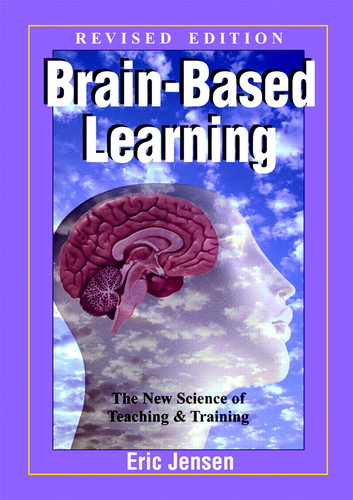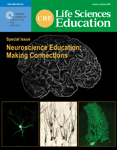A New Formula for Better Learning: A Cup of Common Sense and a Dash of Neuroscience?
“Brain-based learning,” that is, taking an approach to learning based on the way the brain is naturally designed to learn, is a hot topic among educators today. With pressure on the classroom to produce evidence-based outcomes, usually defined as performance on mandatory assessment tests, both teachers and parents are eager to identify ways of optimizing children's learning experiences in the classroom and extracurricular environments. This book by Eric Jensen, one of the “popularizers” of brain-based learning, provides a broad-based introduction to taking neuroscientific research into account in the learning process.
Putting aside my background as a scientist for a moment and, instead, looking at the book as an overscheduled, educated parent (two teenage girls), I found the book to be well organized and an easy read. In addition to illustrations for key points, which are helpful to non-neuroscientists, set-aside boxes entitled “What Does This Mean to You?” offer practical tips that help educators apply the information to their students. A series of reflection questions at the end of each chapter makes it easy to adapt the book to a discussion-group format. Combined, these features encourage a “reflection to action” mode for the reader to consider the information in the context of their own experience and then how they will go about actively using this knowledge in their particular learning environment (most often, a classroom).
The book begins with an explanation of what constitutes brain-based learning and confronts critics' arguments against this approach. The first few chapters in the book examine the structure and function of the brain, with attention given to cellular mechanisms of learning postulated to occur at the neuronal level and how circadian rhythms may be influential. Several chapters consider other factors, such as environmental, social, and emotional inputs that could plausibly impact learning, especially in the traditional classroom setting. The last few chapters consider “essentials of brain-based learning” such as maximizing learning results by constructing “brain-compatible classrooms and curricula” and rethinking assessment and discipline strategies.

From my vantage point as a parent who has spent time volunteering in K–8 classrooms throughout the last few years, as well as an educator teaching in the undergraduate curriculum, I liked many of the practical suggestions that could enhance learning for particular individuals. Several of these suggestions and tips will be recognized by experienced educators as inherent in descriptions of “good” teaching practices. For example, Jensen suggests starting a new lesson with a brief review of what had previously been covered, that is, making connections to prior learning. Experienced parents will likewise recognize suggestions that would be characterized as “good parenting practices” such as making sure your child is not a couch potato, providing a nutritious diet, and making sure he/she gets enough sleep. The book simply takes these good practices a step further and ties them to the ways that the brain may process and cement learning into synaptic circuits. I found myself wanting to copy a few of these suggestions and send them on to my daughter's eighth-grade math teacher, painfully coping with his first year in the classroom. My attitude toward many of these suggestions and approaches is—why not give them a try? They might not benefit all students but certainly would not be harmful. Many were rather benign in nature, such as encouraging the teacher to greet the students at the door, promoting involvement in extracurricular activities, and using pre-exposure and group activities.
I admit that I also read the book from my current status as a “nontraditional” student, back in school for vocational retraining, like many other adults my age who have found it necessary to return to school to prepare for a second career or obtain an advanced degree to increase career options. I know from my own experiences that, with my “aged” brain, for learning to “stick,” I need to approach it differently than I did in my teens. Those, like myself, who teach classes with ever-increasing numbers of nontraditional students clearly recognize the possibility that we may need to develop new habits of mind at different stages of life if we are to learn effectively. In addition, because I teach my classes via the Web, I was particularly looking for information that could be applied to the older student learning through distance education. However, even though looking through the table of contents suggests that the book contains information relevant to developing the “life-long” learner or teacher, this book does not contain that kind of information. Instead, it is clearly geared toward the K–12 teacher and classroom experience, leaning more toward the K–8 range, with little specific information relevant to teaching the adolescent teenager in the high school classroom or the re-entry adult learner. Recent research regarding the development of the teenage brain, particularly the implications for learning of prefrontal cortex development in adolescents, is missing.
This limitation leads me to return to the book once more, this time as a neuroscientist. Although there have been great discoveries and advances in the last two decades concerning brain structure and function, even at the molecular level, a great divide remains between knowledge derived from basic research and how those findings might be effectively applied in the classroom. Thus, I reviewed the content skeptically, wondering if one particular finding of a study could really lead to that particular learning application. Because the last edition of the book was published in 2000, some of the research studies referenced are now almost 20 years old. Further, the resources upon which the book is based include only a few studies drawn from premier research journals (The Journal of Neuroscience), and many of the references are not primary sources, but secondary (books). I particularly disliked the chapter on brain-based discipline, both as a scientist and a parent. For example, Jensen suggests that “… most problem-behaviors originate from an area of the brain unable to will away an inappropriate behavior.” This statement struck me as the basis for arguing that “it really wasn't little Jane or Johnny's conscious fault—it's the wiring in their brain that's not working right.” Yet as a neuroscientist whose research area has focused on body fluid homeostasis, I could soundly agree with the research-based arguments that students need to have access to water and skip drinks high in caffeine or sugar. The bottom line is that scientists can probably read the book and separate the proverbial “wheat from the chaff,” but some nonscientists may perceive the information presented as gospel.
With an enjoyable format, Jensen has done a masterful job of weaving references together from many arenas of neuroscience to support the assertions made about brain-based learning, and they appear quite plausible to the nonscientist. As mentioned previously, a lot of what is in the book falls under already known good teaching and good parenting practices, and certainly the success of those practices lies in their ability to influence behavior. In a sense, all learning is fundamentally “brain-based.” If one views this book as a compendium of positive and motivating practices that can potentially contribute to enhance the learning process in the K–12 classroom, then it's a valuable read. Grounding the justifications for these practices in neuroscience research and conceptualizing them as “brain-based” was a bit of a stretch for me, especially when it comes to those falling into the category of “mind–body” interactions. Nevertheless, in spite of these reservations, I think I'll go copy that chapter on the “Nonconscious Learning Climate” for the new math teacher. It might help him out a bit with those eighth graders!



